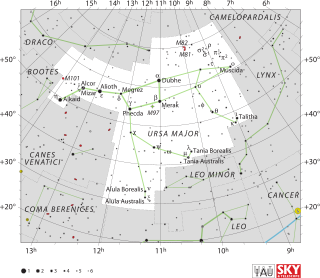| Observation data Epoch J2000.0 Equinox J2000.0 | |
|---|---|
| Constellation | Ursa Major |
| Right ascension | 08h 40m 12.81767s[1] |
| Declination | +64° 19′ 40.5700″[1] |
| Apparent magnitude (V) | +4.620[2] |
| Characteristics | |
| Spectral type | K2 III[3] |
| U−B color index | +1.193[2] |
| B−V color index | +1.159[2] |
| Astrometry | |
| Radial velocity (Rv) | +14.62[4] km/s |
| Proper motion (μ) | RA: −60.05[1] mas/yr Dec.: +26.40[1] mas/yr |
| Parallax (π) | 12.74 ± 0.26 mas[1] |
| Distance | 256 ± 5 ly (78 ± 2 pc) |
| Absolute magnitude (MV) | 0.150[3] |
| Details | |
| Mass | 1.234 ± 0.15[5] M☉ |
| Radius | 18.79±0.38[6] R☉ |
| Luminosity | 112.4±10.0[6] L☉ |
| Surface gravity (log g) | 1.8 ± 0.15[5] cgs |
| Temperature | 4336±99[6] K |
| Metallicity [Fe/H] | -0.25 ± 0.04[5] dex |
| Rotational velocity (v sin i) | 8[7] km/s |
| Age | 4.18 ± 1.95[3] Gyr |
| Other designations | |
| Database references | |
| SIMBAD | data |
4 Ursae Majoris (sometimes abbreviated 4 UMa) is the Flamsteed designation of a star in the northern circumpolar constellation of Ursa Major. It also bears the Bayer designation of Pi2 Ursae Majoris (Pi2 UMa, π2 Ursae Majoris, π2 UMa) and is traditionally named Muscida. With an apparent visual magnitude of +4.6,[2] this star is visible from suburban or darker skies based upon the Bortle Dark-Sky Scale. From parallax measurements made during the Hipparcos mission, this star is at a distance of 256 light-years (78 parsecs) from Earth.[1] As of 2011[update], one extrasolar planet has been confirmed to be orbiting the star.
- ^ a b c d e f Cite error: The named reference
aaa474_2_653was invoked but never defined (see the help page). - ^ a b c d Cite error: The named reference
mnras172_667was invoked but never defined (see the help page). - ^ a b c Cite error: The named reference
aaa480_1_91was invoked but never defined (see the help page). - ^ Cite error: The named reference
aaa430_165was invoked but never defined (see the help page). - ^ a b c Cite error: The named reference
aaa472_2_649was invoked but never defined (see the help page). - ^ a b c Cite error: The named reference
Baines2010was invoked but never defined (see the help page). - ^ Cite error: The named reference
coapa239_1_1was invoked but never defined (see the help page).
